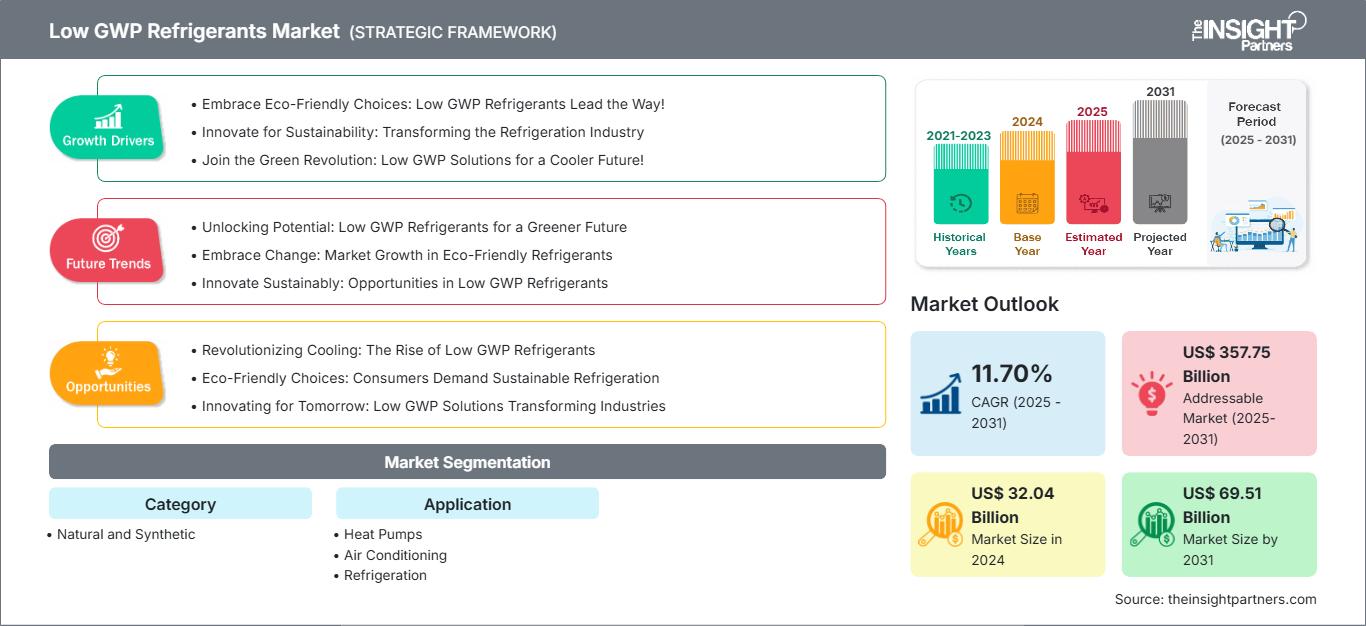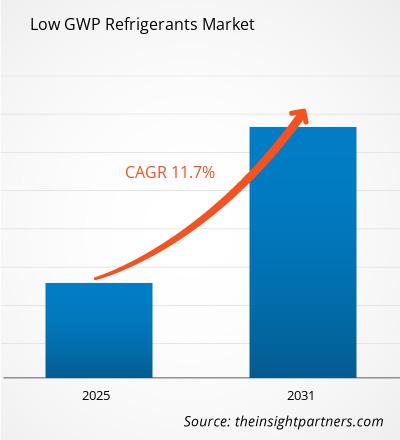Le marché des réfrigérants à faible PRG devrait enregistrer un TCAC de 11,70 % entre 2025 et 2031, avec une taille de marché passant de 32,04 milliards USD en 2024 à 69,51 milliards USD d'ici 2031.
Le rapport est classé par catégorie (naturel et synthétique) et analyse le marché en fonction de son application (pompes à chaleur, climatisation, réfrigération). Une analyse détaillée est fournie aux niveaux mondial, régional et national pour chacun de ces segments clés.
Le rapport présente la taille et les prévisions du marché pour tous les segments, en dollars américains. Il fournit également des statistiques clés sur l'état actuel du marché des principaux acteurs, ainsi qu'un aperçu des tendances actuelles et des opportunités émergentes.
Objectif du rapport
Le rapport sur le marché des réfrigérants à faible PRG, publié par The Insight Partners, vise à décrire le paysage actuel et la croissance future, les principaux moteurs, les défis et les opportunités. Il fournira des informations aux différents acteurs du secteur, notamment :
- Fournisseurs/fabricants de technologies : pour comprendre l’évolution de la dynamique du marché et connaître les opportunités de croissance potentielles, leur permettant de prendre des décisions stratégiques éclairées.
- Investisseurs : Effectuer une analyse complète des tendances concernant le taux de croissance du marché, les projections financières du marché et les opportunités qui existent tout au long de la chaîne de valeur.
- Organismes de réglementation : Réglementer les politiques et les activités de police sur le marché dans le but de minimiser les abus, de préserver la confiance des investisseurs et de maintenir l’intégrité et la stabilité du marché.
Segmentation du marché des réfrigérants à faible PRG
Catégorie
- Naturel et synthétique
Application
- Pompes à chaleur
- Climatisation
- Réfrigération
Vous bénéficierez d'une personnalisation gratuite de n'importe quel rapport, y compris des parties de ce rapport, ou d'une analyse au niveau des pays, d'un pack de données Excel, ainsi que de superbes offres et réductions pour les start-ups et les universités.
Marché des réfrigérants à faible PRG : perspectives stratégiques

-
Obtenez les principales tendances clés du marché de ce rapport.Cet échantillon GRATUIT comprendra une analyse de données, allant des tendances du marché aux estimations et prévisions.
Moteurs de croissance du marché des réfrigérants à faible PRG
- Adoptez des choix écologiques : les réfrigérants à faible PRG ouvrent la voie !
- Innover pour la durabilité : transformer l'industrie de la réfrigération
- Rejoignez la révolution verte : des solutions à faible PRG pour un avenir plus frais !
Tendances futures du marché des réfrigérants à faible PRG
- Libérer le potentiel : des réfrigérants à faible PRG pour un avenir plus vert
- Adopter le changement : croissance du marché des réfrigérants écologiques
- Innover durablement : opportunités dans les réfrigérants à faible PRG
Opportunités du marché des réfrigérants à faible PRG
- Révolutionner le refroidissement : l'essor des réfrigérants à faible PRG
- Choix écologiques : les consommateurs exigent une réfrigération durable
- Innover pour demain : des solutions à faible PRG transforment les industries
Aperçu régional du marché des réfrigérants à faible PRG
Les tendances et facteurs régionaux influençant le marché des réfrigérants à faible PRG tout au long de la période de prévision ont été analysés en détail par les analystes de The Insight Partners. Cette section aborde également les segments et la répartition géographique du marché des réfrigérants à faible PRG en Amérique du Nord, en Europe, en Asie-Pacifique, au Moyen-Orient et en Afrique, ainsi qu'en Amérique du Sud et en Amérique centrale.
Portée du rapport sur le marché des réfrigérants à faible PRG
| Attribut de rapport | Détails |
|---|---|
| Taille du marché en 2024 | 32,04 milliards de dollars américains |
| Taille du marché d'ici 2031 | 69,51 milliards de dollars américains |
| TCAC mondial (2025 - 2031) | 11,70% |
| Données historiques | 2021-2023 |
| Période de prévision | 2025-2031 |
| Segments couverts |
Par catégorie
|
| Régions et pays couverts |
Amérique du Nord
|
| Leaders du marché et profils d'entreprises clés |
|
Densité des acteurs du marché des réfrigérants à faible PRG : comprendre son impact sur la dynamique des entreprises
Le marché des réfrigérants à faible PRG connaît une croissance rapide, porté par une demande croissante des utilisateurs finaux, due à des facteurs tels que l'évolution des préférences des consommateurs, les avancées technologiques et une meilleure connaissance des avantages de ces produits. Face à cette demande croissante, les entreprises élargissent leur offre, innovent pour répondre aux besoins des consommateurs et capitalisent sur les nouvelles tendances, ce qui alimente la croissance du marché.

- Obtenez un aperçu des principaux acteurs du marché des réfrigérants à faible PRG
Principaux arguments de vente
- Couverture complète : Le rapport couvre de manière exhaustive l’analyse des produits, des services, des types et des utilisateurs finaux du marché des réfrigérants à faible GWP, offrant un paysage holistique.
- Analyse d’experts : Le rapport est compilé sur la base d’une compréhension approfondie des experts et analystes du secteur.
- Informations à jour : Le rapport garantit la pertinence commerciale en raison de sa couverture des informations récentes et des tendances des données.
- Options de personnalisation : ce rapport peut être personnalisé pour répondre aux exigences spécifiques du client et s'adapter parfaitement aux stratégies commerciales.
Le rapport de recherche sur le marché des réfrigérants à faible PRG peut donc contribuer à décrypter et à comprendre le contexte et les perspectives de croissance du secteur. Malgré quelques inquiétudes légitimes, les avantages globaux de ce rapport l'emportent généralement sur ses inconvénients.
- Analyse historique (2 ans), année de base, prévision (7 ans) avec TCAC
- Analyse PEST et SWOT
- Taille du marché Valeur / Volume - Mondial, Régional, Pays
- Industrie et paysage concurrentiel
- Ensemble de données Excel
Rapports récents
Témoignages
Raison d'acheter
- Prise de décision éclairée
- Compréhension de la dynamique du marché
- Analyse concurrentielle
- Connaissances clients
- Prévisions de marché
- Atténuation des risques
- Planification stratégique
- Justification des investissements
- Identification des marchés émergents
- Amélioration des stratégies marketing
- Amélioration de l'efficacité opérationnelle
- Alignement sur les tendances réglementaires






















 Obtenez un échantillon gratuit pour - Marché des réfrigérants à faible PRG
Obtenez un échantillon gratuit pour - Marché des réfrigérants à faible PRG